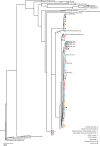High diversity of picornaviruses in rats from different continents revealed by deep sequencing
- PMID: 27530749
- PMCID: PMC5034103
- DOI: 10.1038/emi.2016.90
High diversity of picornaviruses in rats from different continents revealed by deep sequencing
Abstract
Outbreaks of zoonotic diseases in humans and livestock are not uncommon, and an important component in containment of such emerging viral diseases is rapid and reliable diagnostics. Such methods are often PCR-based and hence require the availability of sequence data from the pathogen. Rattus norvegicus (R. norvegicus) is a known reservoir for important zoonotic pathogens. Transmission may be direct via contact with the animal, for example, through exposure to its faecal matter, or indirectly mediated by arthropod vectors. Here we investigated the viral content in rat faecal matter (n=29) collected from two continents by analyzing 2.2 billion next-generation sequencing reads derived from both DNA and RNA. Among other virus families, we found sequences from members of the Picornaviridae to be abundant in the microbiome of all the samples. Here we describe the diversity of the picornavirus-like contigs including near-full-length genomes closely related to the Boone cardiovirus and Theiler's encephalomyelitis virus. From this study, we conclude that picornaviruses within R. norvegicus are more diverse than previously recognized. The virome of R. norvegicus should be investigated further to assess the full potential for zoonotic virus transmission.
Figures




References
-
- Hugh-Jones ME, Hubbert WT, Hagstad HV. Zoonoses. Hoboken: Blackwell Publishing. 2000.
-
- Himsworth CG, Parsons KL, Jardine C et al. Rats, cities, people, and pathogens: a systematic review and narrative synthesis of literature regarding the ecology of rat-associated zoonoses in urban centers. Vector Borne Zoonotic Dis 2013; 13: 349–359. - PubMed
-
- Meerburg BG, Singleton GR, Kijlstra A. Rodent-borne diseases and their risks for public health. Crit Rev Microbiol 2009; 35: 221–270. - PubMed
-
- Maurice H, Nielen M, Vyt P et al. Factors related to the incidence of clinical encephalomyocarditis virus (EMCV) infection on Belgian pig farms. Prev Vet Med 2007; 78: 24–34. - PubMed
-
- Spyrou V, Maurice H, Billinis C et al. Transmission and pathogenicity of encephalomyocarditis virus (EMCV) among rats. Vet Res 2004; 35: 113–122. - PubMed
MeSH terms
Substances
Grants and funding
LinkOut - more resources
Full Text Sources
Other Literature Sources
Medical
Molecular Biology Databases
